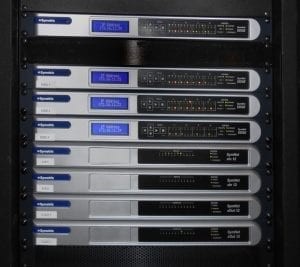The Katy Independent School District, AV Systems Conversion

Katy Independent School District, Katy, TX United States
The Katy Independent School District is an award-winning public school system based in Katy, Texas that enrolls over 60,000 students. It makes heavy use of audio and video display capabilities to augment its live and pre-recorded school presentations. The district, which serves 181 square miles in parts of Harris County, Fort Bend County and Waller County, undertook a $700,000 audio and video systems conversion project beginning in May 2013.
Challenge
Today’s high schools are working hard to create presentations that will both stimulate the students’ imaginations and hold their interest in a world of video games and endless video program consumption. The Katy Independent School District undertook a massive project this summer to upgrade the audio and video capabilities at four of its largest schools (Katy High School, Taylor High School, Mayde Creek High School and Cinco Ranch High School, all built in the mid-1990s). The project transitioned each school’s Performing Arts Center from clunky analog to the improved quality of digital technology.
System integrator Broadcast Works (Tyler, Texas) was challenged with upgrading the existing (and aging) analog infrastructure throughout each facility’s main auditorium with next-generation Cat-5 cable and proven Internet Protocol (IP) signal delivery. Aaron Comer, a manager at Broadcast Works who supervised the Katy School District project, said the goal was improved A/V system flexibility over the existing “fixed” copper cable system, connecting the back-of-house control room to the main stage with its roughly 78 audio input sources (including both mic and line level sources).
Solution
Broadcast Works initiated the project over the summer, first replacing the entire existing copper cabling with affordable CAT-5 cable. Comer and his team “lobbied hard” for Symetrix solutions with Audinate Dante networking inside to support stable, long-distance signal distribution. The complete solution includes a Symetrix SymNet Edge and Radius AEC DSP system for audio routing and processing, featuring Dante inside to move high-quality audio between the stage and sound booth at each location with very low latency.
Comer notes that the Dante solution gave him and his team the opportunity to eliminate the long home cable runs that previously existed to connect the stage inputs to the sound booths. The SymNet Radius AEC DSP, located onstage, take in sources instead for distribution to the sound booth. Meanwhile, the SymNet Edge DSP incorporates wireless and hardwired microphone sources from four onstage Dante networking ports. Once received at the sound booth, sources are mixed on the 48-channel house audio console and then redistributed as either a single source or a multiplexed AV signal.

Because each school has more channels (78) than the house console can handle at once, the Katy School District uses Dante as a “virtual digital patch panel.” This means that users (including students) can select among the 78 channels signals with simplicity, and allocate the selected sources to the console. Broadcast Works additionally designed a custom PC-based control interface using Symetrix SymVue software to connect any input to any console channel.
“Symetrix with Dante technology inside is our preferred technology for projects of this type because it allows us to provide a lot of functionality for a very low price,” said Comer. “The DSP signal flow of these schools is huge, but the Dante technology can handle it with no problem. And, using IP as our delivery method, it’s flexible and there’s never any latency or signal quality issues, ever.”
He also said that because the cost of the technology was very affordable, they could stay within budget while adding three Cat-5 lines (two for redundancy and future growth).
“Clients love it when we finish a job and realize they can do so much more with all of those ugly audio and video cables they used to have laying all over the place,” Comer said. “It makes the job rewarding.”
Benefits and Savings
- Lowest cost solution for installation and high quality, multi-channel audio signal processing and distribution
- Scalable and flexible architecture for future system expansion and technology upgrades
- Analog-to-digital conversion of the schools’ A/V system allows staff to improve quality and retention rate of live and pre-recorded stage presentations



